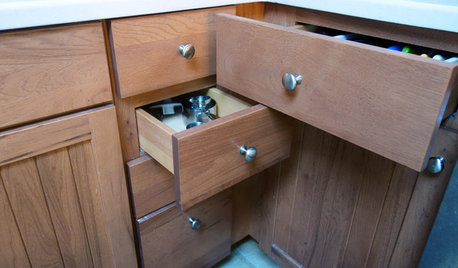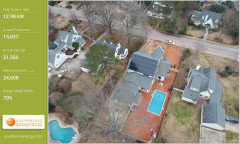How many kWh does a heat pump use
margaret17
2 years ago
Featured Answer
Comments (54)
margaret17
2 years agoRelated Discussions
Geothermal heat pump vs air source heat pump vs gas
Comments (27)Air source heat pumps don't make sense in areas where winter temps frequently fall below 32 degrees. Once you get below freezing, you will be running the auxillary heat a lot. If you decide to go the air source route, you will want a second stage gas fired auxillary heat. I live in the mid-atlantic region in the mountains and selected GT. That choice was coupled with a blown cellulose insulation package. My other choice was a propane heat/electric AC with a foam insulation package. Both options were roughly the same install cost. Both would have provided similar energy efficiency. At the time we selected, propane was 3.75 a gallon and rising (with no end in sight) so we went with GT. The delta cost for the GT system (above the cost for a HE propane heat and electric AC system) was $15,000 for the heat pumps and loop plumbing (including pumps) plus $17,000 for digging the pit. The pit excavation should not have cost as much as it did but it is a 12 ton system and the hole was gigantic (120' x 48' x 6'). We live on a mountain and hit a bunch of boulders that required special equipment to get out. Rocky soil also required a 1' base of stone dust to cover the loop piping. The total cost for the GT HVAC system including all ducting was $50,000 plus the pit excavation cost of 17K. It is a large investment and I would only recommend it if you plan to live in the house a very long time. My heating bills are great - maybe 300 dollars maximum a month during peak winter for an 8500 square foot home (5900 living and the rest a condiitoned but unfinished basement). Make sure that whatever equipment you choose can be maintained by more than 1 very qualified HVAC company who has many years of GT experience. In my area there is only 1 GT company who has over 20 years of experience but I am stuck with them for maintenance. There have been times when I wanted to fire them but cannot. Local competition is a good thing. Also - if you build a tight home make sure that you consider ventilation and dehumidification in the HVAC design. I wound up adding both a whole house dehumidifier and energy recovery vent after we moved in becuase we had basement moisture issues as well as stale air in the winter. Tight homes are great for energy efficiency but can create health issues too. It is easy to deal with as long as you plan for it. Good luck with the build....See MoreHeat Pump only or dual fuel?
Comments (14)Tim: If I'm understanding this correctly, you can only get $1,500 max for your tax credit (even if you buy two units), and if I'm understanding these Carrier salesmen who are giving me estimates, the tax credit reduces your taxable income by $1,500. The true amount of cash savings that you realize at the bottom line of your tax return might be only half of that (it all depends on your tax rate). I would ask for a copy of the ARI (Air Conditioning and Refrigeration Institute) certificate that shows that the entire unit, breaking down each piece that when installed together makes your system, qualifies for the tax credit before you put any money down. Only one of my four estimates came with a copy of a ARI certifcate showing that it qualified. The rest just didn't provide the evidence that the unit they were proposing met the tax credit requirements. You don't want any surprises next April, especially if you are really depending on that money....See MoreNew heat pumps cool well but we need heat
Comments (11)tigerdunes - I have learned a lot from reading your postings on this forum and I appreciate your inputs. Your minimum specs list has already been very useful (though a lot of sales people really struggle to find answers about some of the items on that list), and IâÂÂm leaning now toward the XL15i instead of the $660 more expensive XL16i. I still havenâÂÂt completely ruled out Carrier and Rheem, but a neighbor has had a 4-ton Trane XL14i for over three years and I like the way it does not seem to have collected very many of the evergreen needles that are everywhere around here. I am curious though just why the XL16i has so much trouble with dehumidification, and whether that is important to our well-shaded house just outside of Seattle. We havenâÂÂt bothered to run our heat pump in cooling mode for at least the last decade, so I remain mostly concerned with heating performance and expect to use very little cooling. Also, is the XL16i any less reliable that the XL15i, or is it just (as I understand from other forum postings) that it is more complex to hook up and hence more prone to improper installation? I am also puzzled when I compare ARI heating performance of the XL15i and XL16i. At 47 degrees their ARI heat capacity and COP are identical, and at 17 degrees the 15i has only 1% more heat capacity. The 16i has the better 17 degree COP, 2.86 versus 2.82, but it falls down on HSPF to 8.50 versus 9.00 for the 15i. This seems to imply that the 16i spends more time in defrost mode, but I do not understand why. Returning of your spec list, I assume âÂÂstaged backup heat stripsâ refers to the capability to selectively turn on part instead of all of the backup heat? Our old heat pump has this feature, but I have yet to find a sales person who can tell be whether modern systems can do this. One issue is not really relevant until our new heat pump is being installed, but opinions about it are so amusingly diverse I cannot resist asking. Our power utility offers an extra rebate if we install a lockout control. What should it control? We have a lockout set at 32 degrees on our old heat pump and I understood it prevents the backup heat from coming unless the outdoor temperatures is below 32 degrees. The âÂÂenergy expertâ I talked to at our power company agreed, but said the lockout should also turn off the heat pump compressor at 32 degrees to âÂÂprevent a spike in our electric bill.â I recognize efficiency is down at that temperature, but unless there is a lot of icing up it still seems to make sense to run the compressor. Sale personnel were about evenly split whether the lockout should turn off the compressor. Is there any clear answer on this?...See MoreDoes anyone know the running/operating cost of heat pumps?
Comments (6)For the electricity it seems you are buying the electricity from another provider. There is delivery charge from National grid for $61.49, and a service charge of $75.71 from another supplier. The average cost for 701 kWh is $0.196 per kWh. That is is expensive. You probably would get a better rate if you bought your electricity from National Grid. National grid also offers other types of billing. You should call them and ask about all the available options. The gas chart is showing a price of $0.22 per therm. That is very low so I suspect that is only the delivery charge. Are there more details on your bill showing the service charge?...See Morecobalty2004
2 years agomargaret17
2 years agomike_home
2 years agomargaret17
2 years agowdccruise
2 years agolast modified: 2 years agoElmer J Fudd
2 years agolast modified: 2 years agomike_home
2 years agoDavid Cary
2 years agolast modified: 2 years agomike_home
2 years agolast modified: 2 years agoElmer J Fudd
2 years agomtvhike
2 years agomargaret17
2 years agolast modified: 2 years agoDavid Cary
2 years agomargaret17
2 years agoDavid Cary
2 years agoElmer J Fudd
2 years agofsq4cw
2 years agolast modified: 2 years agoElmer J Fudd
2 years agolast modified: 2 years agofsq4cw
2 years agoDavid Cary
2 years agolast modified: 2 years agomargaret17
2 years agofsq4cw
2 years agoElmer J Fudd
2 years agolast modified: 2 years agodadoes
2 years agoDavid Cary
2 years agolast modified: 2 years agomike_home
2 years agomargaret17
2 years agoDavid Cary
2 years agolast modified: 2 years agomike_home
2 years agoDavid Cary
2 years agolast modified: 2 years agofsq4cw
2 years agolast modified: 2 years agoElmer J Fudd
2 years agolast modified: 2 years agoDavid Cary
2 years agomike_home
2 years agomargaret17
2 years agoElmer J Fudd
2 years agofsq4cw
2 years agolast modified: 2 years agomike_home
2 years agoElmer J Fudd
2 years agolast modified: 2 years agokevin9408
2 years agolast modified: 2 years agoElmer J Fudd
2 years agolast modified: 2 years agokevin9408
2 years agolast modified: 2 years agoElmer J Fudd
2 years agoDavid Cary
2 years agoMatt M
last yearmargaret17
last yearDavid Cary
last yearlast modified: last year
Related Stories

GARDENING AND LANDSCAPINGSimple Pleasures: Beat the Heat With Water
Quench your thirst and satisfy your need for summery joys by tapping into the many wonders of water
Full Story
GREEN BUILDINGHouzz Tour: Passive House in Vermont Slashes Heating Bills
Its ecofriendly, low-maintenance design leaves a family with more time to relax and enjoy the weekend home
Full Story
FLOORSIs Radiant Heating or Cooling Right for You?
Questions to ask before you go for one of these temperature systems in your floors or walls (yes, walls)
Full Story
GREEN BUILDINGInsulation Basics: Heat, R-Value and the Building Envelope
Learn how heat moves through a home and the materials that can stop it, to make sure your insulation is as effective as you think
Full Story
FLOORSFloors Warm Up to Radiant Heat
Toasty toes and money saved are just two benefits of radiant heat under your concrete, wood or tile floors
Full Story
BATHROOM DESIGNWarm Up Your Bathroom With Heated Floors
If your bathroom floor is leaving you cold, try warming up to an electric heating system
Full Story
REMODELING GUIDESBathroom Workbook: How Much Does a Bathroom Remodel Cost?
Learn what features to expect for $3,000 to $100,000-plus, to help you plan your bathroom remodel
Full Story
GREAT HOME PROJECTSHow to Add a Radiant Heat System
Enjoy comfy, consistent temperatures and maybe even energy savings with hydronic heating and cooling
Full Story
MOVINGWhy So Many New U.S. Homes Are Supersized
A bigger share of new homes sold in 2015 were 4,000 square feet or more compared with before the recession. But that could change
Full Story
FUN HOUZZ10 Truly Irritating Things Your Partner Does in the Kitchen
Dirty dishes, food scraps in the sink — will the madness ever stop?
Full Story



David Cary